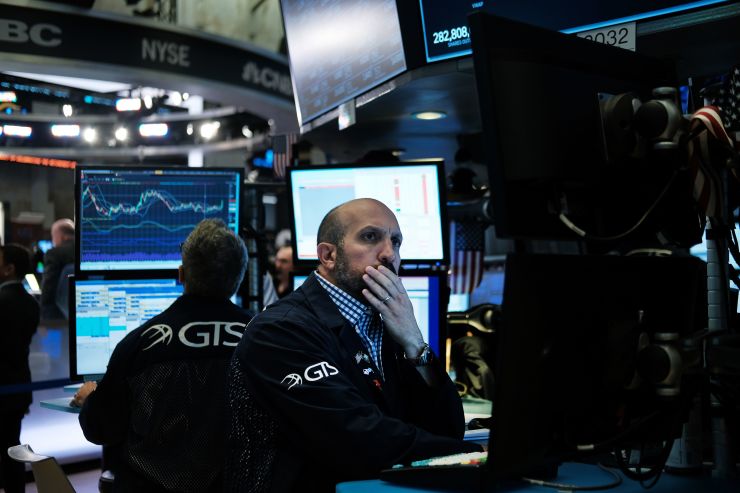
Stocks pulled back sharply last month as investors fretted over U.S. trade relations with China and Mexico and worries over global economic growth. However, drops like this one are more common than people think.
Ben Carlson, director of institutional asset management at Ritholtz Wealth Management, pointed out in a tweet Wednesday that 5% pullbacks in the S&P 500 have happened in 65 of the past 70 years. He also noted there have been just five years without such a decline since 1950: 1954, 1958, 1964, 1995 and 2017.
“We all remember what happened in the fourth quarter. That colors people’s beliefs when trade-war worries intensify,” said Brent Schutte, chief investment strategist at Northwestern Mutual Wealth Management. Also, “Post the Great Recession, people have been on the razor’s edge every time the market declines. I think we all have PTSD in some way.”
“That provides a backdrop for why people tend to overreact to when the market falls in a normal trend,” Schutte said.
The S&P 500 fell 6.6% in May. It was its first monthly decline of 2019, snapping a four-month winning streak.
Sell-off sparked by Trump tweets
The decline in equities started after President Donald Trump threatened to hike tariffs on $200 billion worth of Chinese goods. In a series of May 5 tweets, Trump said: “The Tariffs paid to the USA have had little impact on product cost, mostly borne by China. The Trade Deal with China continues, but too slowly, as they attempt to renegotiate.”
Trump’s tweets caught the market by surprise as officials from both sides previously indicated that a deal was being worked out. Trump followed through on his threat on May 10, when the U.S. raised those levies.
China retaliated by hiking tariffs on $60 billion worth of goods. The U.S. followed that move by effectively banning U.S. companies from doing business with Huawei, a giant telecommunications company in China.
Increasing U.S.-China trade tensions proved problematic for Apple and several large chipmakers. Apple fell more than 12% for the month. Shares of Micron Technology, Nvidia, Qualcomm and Skyworks Solutions dropped more than 20% in May. The VanEck Vectors Semiconductor ETF (SMH) ended the month down more than 15%. These companies have large parts of their supply chain in China, so higher tariffs increase their cost of business there.
Salvatore Ruscitti, U.S. equity strategist at MRB Partners, notes investors should remain cautious on semiconductors given their high exposure to China.
“Chip stocks will remain vulnerable until U.S./China trade negotiations improve. We recommend staying on the sidelines with a neutral stance,” he wrote in a note Thursday. “A further significant escalation in the U.S./China trade dispute that restricts access to the fast-growing Chinese market would represent a significant threat to the longer-term prospects of the semiconductor industry and warrant a downgrade of the sub-group to underweight.”
The stocks sell-off intensified on Friday, the last trading day of the month, after Trump threatened applying a 5% to Mexican imports. Trump said the tariffs would take effect on June 10 and would rise gradually increase “until the Illegal Immigration problem is remedied.” The White House also said in a statement that tariffs on Mexican goods could rise to as high as 25%.
Shares of Constellation Brands dropped 6.6% on Friday. General Motors and Ford Motor, two automakers with significant operations in Mexico, fell 4.3% and 2.3%, respectively.
Bond yields collapse
Intensifying trade tensions led investors to load up on traditionally safer Treasurys at the expense of equities.
The benchmark 10-year yield — which moves inversely to prices — fell from around 2.5% at the start of May to about 2.12%, near its lowest level in 20 months. That decline led to a yield-curve inversion, with the 3-month bill rate trading above its 10-year counterpart.
An inverted yield curve is seen by experts as a sign that a recession may loom ahead. Bond yields overseas also fell, as global investors also worried about a slowdown in the global economy.
“Bond yields usually decline significantly prior to recessions and often in tandem with a collapsing stock market. Consequently, the similarity that investors have experienced during the last couple weeks cannot be ignored,” Jim Paulsen, chief investment strategist at The Leuthold Group, said in a note.
“However, investors should also recognize that so far, confidence in the private sector of the economy … has not only remained healthy but has recently strengthened despite ongoing trade-war negotiations and despite worsening fears in the bond market,” he said.
Where stocks go from here is a toss-up
It is unclear where stocks will go from here, even when looking at historical data.
Sam Stovall, chief investment strategist at CFRA Research, pointed out in a tweet Thursday that, since World War II, “hefty” gains in the S&P 500 between January and April are “typically digested” in May. Stovall added the digestion period is followed by solid gains in June.
Data compiled by LPL Financial signals more losses could loom ahead, however. The firm said in a post Thursday the S&P 500 has averaged a loss of nearly 1% over the past 20 years. LPL added the S&P 500 has dropped more than 5% in May just four times in the past 50 years. Subsequently, the index has lost more than 5% in June on two occasions.
But Craig Callahan, president at Icon Funds, thinks this decline is a buying opportunity.
“We’re clearly oversold and we’re finding good value,” he said. “We’re finding the overall market to be about 13% below our estimate of fair value. That’s just about the way it was priced when we hit the lows on Dec. 24.”






















